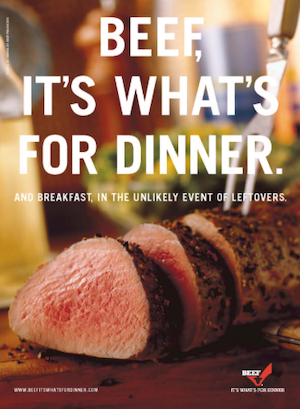You’ve perfected a new product or created a new category that’s sure to benefit a large target audience — but no one knows about it yet. Or maybe you’re a distributor selling an already established product — but it has fallen out of favor and usage has declined.
Either way, to successfully promote and sell the product, you’ll need primary demand advertising.
What is primary demand advertising?
Primary demand advertising (PDA) drives demand for a product class or type of product, without focusing on a particular brand. It educates consumers on the benefits of an entire product class instead of highlighting one brand’s benefits (or their product benefits) over another:

How is primary demand different than selective demand advertising?
In contrast to PDA, selective demand advertising is meant to enhance a brand’s image or reputation. Similar to brand advertising — used to establish brand identity, credibility, and loyalty for stronger, long-term relationships over time — selective demand depicts the brand itself as the best match for the needs of the target market over competing companies.
Selective demand ads generally distinguish the company’s products or services from others based on unique benefits, advantages, or features. Typically, you can identify selective demand advertising because the content of the message is centered on a specific brand. It’s common for the ad to include the brand name as well, like SEMrush in this display ad:

Another major distinction between primary and selective demand advertising is that PDA often involves singular ad campaigns or short-term messaging strategies.
In addition, primary demand ads usually don’t include a CTA since they’re promoting an entire product category, and not necessarily a specific product, service, or brand like selective demand ads or direct response ads.
It’s important to note that PDA has been proven less successful than selective demand advertising in many cases, because it lacks the persuasive aspect of a company selling its benefits to target customers with a strong need. This is even truer in mature industries. Milk and orange juice, for example, are two categories where primary demand efforts have had little to no positive effects.
When to use PDA
Primary demand ads are mainly used in one of two scenarios:
- To launch an entirely new product or product category (aka pioneer advertising)
- To garner more attention to a product or product category that already exists, but isn’t well-known or has lost popularity over time
Pioneer advertising is the most common form used when a product or category is in the introductory stage of its life cycle. The idea here is that before any benefits can be talked about, target customers require some education. This is especially true in more complex categories, like technology, where audiences must be informed of the basics before marketers invest in persuasive demand advertising.
Before launching a new product and advertising it, though, it’s critical to know and understand the primary demand of that product:
- Who will the main buyers be?
- How will they purchase the product?
- What is the main reason people should/will use it?
Thus, thorough research should be conducted to determine the primary demand for a product or product category before entering a given market.
Primary demand ads can also be used with established product categories. This is useful when a product’s benefits are not well-known to consumers, when a product category is losing market share, or when a product has lost popularity, and its usage has declined.
5 Primary demand advertising examples
1. Got Milk?
You’ve seen their print ads and commercials. Numerous celebrities have flashed a milk mustache and you’ve likely watched the infamous Aaron Burr commercial…
Perhaps the most well-known primary demand advertising campaign, “Got Milk?” launched when dairy producers realized that milk consumption was declining. Dairy farmers formed an alliance and agreed to promote milk’s health benefits to get more people drinking milk:

2. Cotton: the Fabric of Our Lives
When synthetic fibers started gaining popularity over cotton in the 70s, a group of cotton growers and importers established Cotton Incorporated. The organization took a small cut of every sale, and hired a team of ad executives to launch Fabric of Our Lives campaign:

3. ‘Sunday ho ya Monday, roz khao ande’
Created by the National Egg Coordination Committee in India, this campaign was launched with the objective to increase egg consumption:

4. Pork. The Other White Meat.
This campaign was developed for the National Pork Board in 1987, with a series of ads promoting pork as a white meat alternative to chicken or turkey. “Don’t be blah” was used as another slogan, with unique entree ideas offered such as pork cordon bleu, pork kabobs, and pork à l’orange:

5. Beef. It’s What’s for Dinner.
With a decrease in beef consumption, this ad campaign was created by the National Cattlemen’s Beef Association in 1992:

The big question
How can brands capitalize on PDA even though it’s not brand specific?
With selective demand advertising, one company typically pays for marketing, and naturally, retains all the ROI. In contrast, primary demand advertising usually consists of an agreement and funding from several companies within the same industry who realize that for any of them to achieve individual success, a primary demand has to be established.
For example, “Beef. It’s What’s for Dinner” was paid for by the Cattlemen’s Beef Board — a collaboration of beef producers and distributors.
The same is true for the “Got Milk?” campaign — created by a conglomerate of dairy farmers realizing that milk consumption was declining and something needed to be done to increase it.
In both cases, all of the companies involved agreed that generating a primary demand for the product category was more important than promoting any one brand or its specific products. Instead, with PDA, multiple companies in an industry must pool their resources for each company to succeed.
Boost awareness with primary demand advertising
Although not widely practiced, primary demand advertising can still be extremely beneficial. Whether it’s a new product launch or an existing product on the decline, primary demand advertising can help grow awareness and increase usage.
Once you’ve created your campaigns and people click your ads, deliver them the best post-click landing page. Learn more about capturing more conversions in all of your campaigns with the Marketing Optimization Opportunities Guide here.
